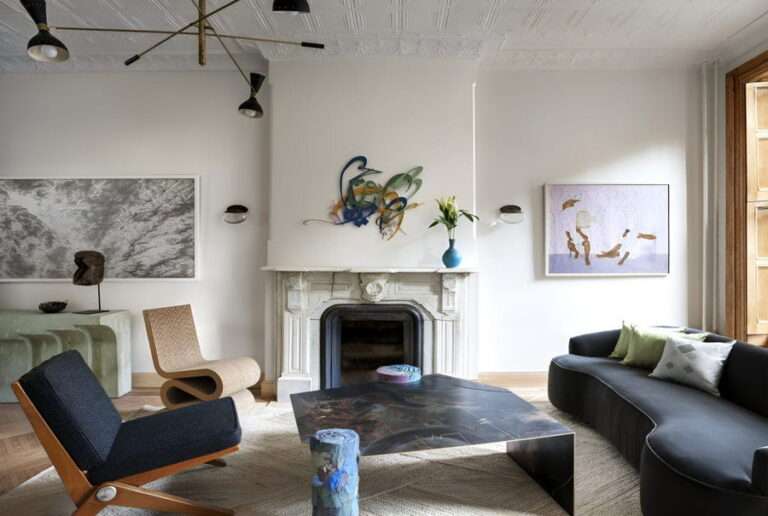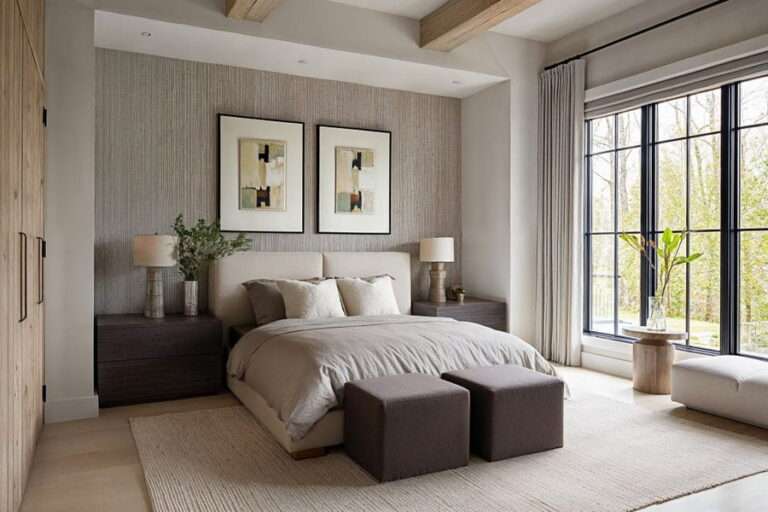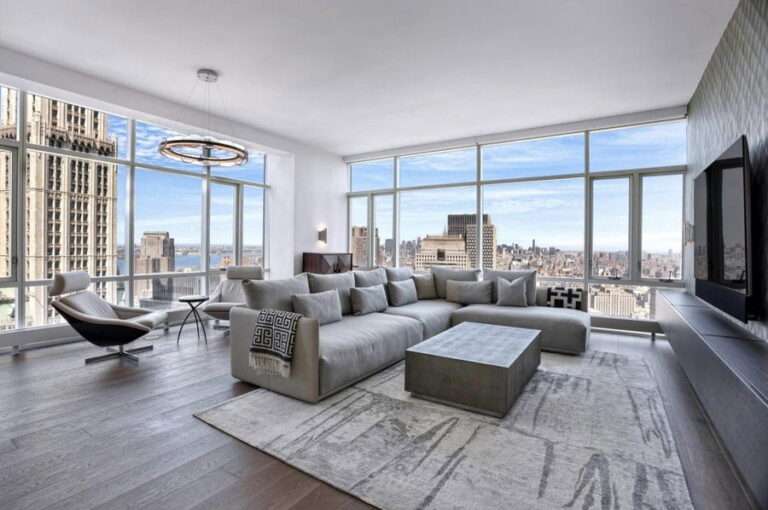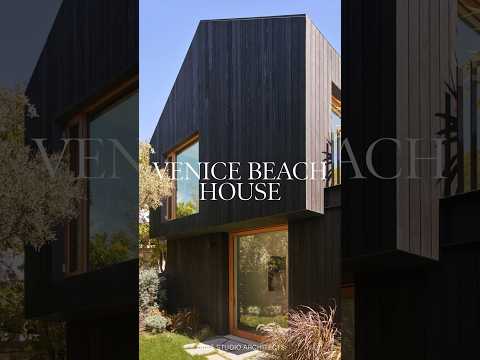Looking to create a bedroom that feels like a peaceful retreat? This recent transformation showcases how a relaxing bedroom design can turn any space into a serene sanctuary. With calming colors, cozy textures, and thoughtful touches, this bedroom became the ultimate place for rest and relaxation.
The Challenge: Relaxing Bedroom Design Ideas
The client reached out to Decorilla to rework a part of their home into something calmer and more livable. They asked for a contemporary bedroom design—something relaxing and neutral that doesn’t involve major changes to the structure. Everything except the doors and light oak flooring was up for reconsideration, so the designer’s tasks were to:
- Choose relaxing paint colors for the bedroom
- Suggest updated lighting
- Propose options for a back wall behind the bed
- Select decor and relaxing bedroom wall art to create a cozy atmosphere
- Blend new furniture and art with existing architectural elements
Pro Tip: Not sure what kind of modern relaxing bedroom design is the best choice for you? Try our Free Interior Design Style Quiz to discover your ideal style today!
Design Inspiration: Relaxing Bedroom Decor With Wall Art
The client found themselves saving images that settled quietly in the mind. Warm monochromes, textured fabrics, soft transitions between walls and wooden floors—that was the rhythm they kept returning to. What drew them in wasn’t style in the conventional sense; it was more about the certain atmosphere. The kind of master bedroom decor that doesn’t need to be rearranged or explained, while light moves through the room gently, changing the tone.
They were especially drawn to large bedrooms that combined structure with softness. The chosen designs contained no loud excess pieces eating up floor space. Just carefully chosen relaxing paint colors for bedroom walls, paired with woven surfaces and art that doesn’t try too hard. Similarly, natural textures and elegant furniture lines weren’t just for show; they solved things.
Initial Concepts: Finding the Right Designer
Once the brief was in, Decorilla matched the client with two professionals—Sharné L. and Esra S. Each designer boasted a consistent record of translating minimal input into focused, livable interiors. The contrast between their moodboards was subtle but meaningful, giving the client two compelling directions for the relaxing bedroom design.
Esra leaned into soft symmetry and a slightly more formal tone. Her proposal paired sculptural lines with warm neutrals and crisp lighting, shaping a space that felt composed and grown-up. In contrast, Sharné’s vision was quieter in mood but richer in atmosphere.
She layered textures instead of shapes, kept the palette grounded, and introduced a few sculptural pieces with more weight. There was also oversized wall art, a curved swivel chair, and bookshelves with negative space.
The room didn’t ask to be styled much further—it was already functioning. That clarity made the decision easier, so the client chose Sharné.
Results Revealed: Relaxing Bedroom Design
The final layout delivers a controlled calm. Every object in the room serves a clear purpose—nothing drifts, nothing clutters. The bed sits low, drawing the eye horizontally rather than vertically, which is critical in a room with exposed beams overhead. Sconces replace table lamps, reducing surface noise and freeing up space on the nightstands. As the client wanted, the palette holds close to relaxing bedroom decor principles: muted browns, off-whites, and softened grays.
Visually, the shift from the original space to the new one is drastic. Yet, it’s not due to large interventions but because of tactical restraint. The old room had too much contrast with too little direction—dark ceiling beams, a glass coffee table, and an isolated fireplace column against bare walls. Nothing anchored the setup. Now, on the other hand, balance and flow dominate the relaxing bedroom design.
The rug defines the sleeping area and softens the transition between the low bed and the pale floor. Two ottomans in front of the fireplace continue its story in the same style. By using a flat, textural weave instead of a deep pile or pattern, the designer maintained a clean visual plane and a lightweight mood.
Ceiling pendants and wall sconces bring organic vibes, along with illumination down to the level of the bed. This layered lighting scheme supports wind-down hours with flexibility. Functional elements like the swivel chair and open shelving are low-profile, avoiding visual blocks while still offering places to sit, store, and display. Even the wall art was chosen for texture above all, so now its tactile weight balances the tall ceiling.
Blending Function with Style
The absence of excessive styling is noticeable. Plants are minimal, bookshelves are not overfilled with relaxing room decor. In addition, the present decorative objects are kept geometric and low-gloss. The room isn’t trying to suggest lifestyle; it’s built to support it. What the designer achieved here is a quiet, functioning system disguised as a bedroom. And that’s what makes it work.
Throughout the process, Sharné provided alternate directions and ideas for the client to consider. One proposal leaned more tonal. Another brought in different light fixtures and stronger contrast. These variations refined the client’s sense of what a relaxing bedroom design meant to them personally as much as stylistically.
Ultimately, the chosen scheme found its strength in grounded accents— oversized artwork, sculptural side tables, and a mix of tactile finishes that feel both current and low-pressure.
Design Details: Sourcing the Perfect Pieces
Decorilla’s 3D visual tools brought clarity to the design before anything was purchased. Thanks to them, the client could see not just individual pieces but also how proportions, materials, and lighting would behave in the actual bedroom. With that kind of visibility, decisions came faster and with more confidence. The access to trade-only pricing also made a difference—furnishings that might have been out of reach elsewhere became part of the plan without stretching the budget unnecessarily.
As the design took shape, Sharné stayed closely tuned to the client’s reactions, adjusting details as required. Her responsiveness became part of the process itself; it shaped not just the look of the space but how it felt to collaborate on it. The client’s feedback said it directly: “Everything looks great! Thanks for all the work, Sharné. I really appreciate it.”
Get the Look: Relaxing Bedroom Design & Decor
A well-composed bedroom doesn’t need excess—just the right pieces placed with intention. Below is a selection chosen for balance, texture, and utility. Each item can work quietly to support a relaxing bedroom without forcing the mood.
Looking for a relaxing bedroom design tailored for you?
Our professional designers take your input and turn it into something precise, functional, and personal. Book your Free Online Interior Design Consultation to get started today!






